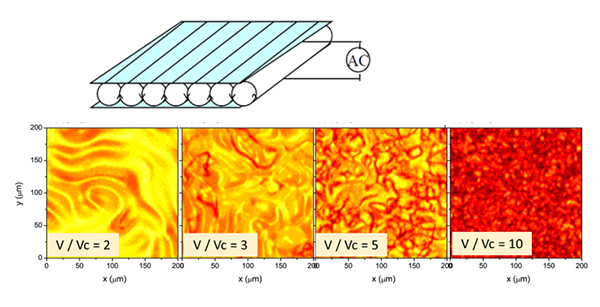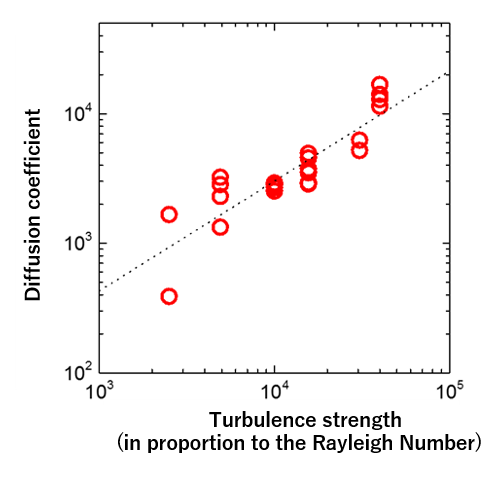HOME > Research Activities > Research Updates >
When we heat water in a pan on the stove, the water at the bottom of the pan is heated and the temperature of all the water in the pan increases. Due to the “convection” that occurs naturally in water, from the bottom to the top of the pan and from the top to the bottom of the pan there occurs a water flow that resembles a circle, warm water and cold water are mixed, and heat is sent to another location. Such a heat transport phenomenon also occurs in plasmas. In extreme high temperature plasmas confined by the magnetic field in the Large Helical Device, those plasmas have been influenced by the outer wall with the lower temperatures, and as time passes the temperature in the plasma core falls. This occurs because the high-temperature plasma in the core and the low-temperature plasma in the edge region are mixed. The transport phenomenon caused by the convection in such a plasma is an important issue for research, and has been closely studied through theory, experiment, and numerical calculation. On the other hand, in comparing plasma with water, air, and common fluids, understanding commonalities and differences, too, is important as academic research. Here, we introduce research on transport phenomena of fluid (plasma being one type of fluid) by utilizing liquid crystal (an intermediate state of liquid and solid) with which we can visually investigate the transport phenomenon.
When we gradually increase the voltage applied to the liquid crystal being used in the display, a convection flow occurs somewhere in the liquid crystal. (This is called the electrical convection.) This convection takes the form in which several eddies are aligned in parallel between electrode plates, and each eddy resembles a roll cake, which is called a “convection roll.” When the voltage is increased further, the eddy (that is, the convection roll) repeatedly breaks off into still smaller eddies. The flow changes into a condition called “turbulence flow,” which is flooded with innumerable small eddies. The advantages of using liquid crystal in experiment are 1) we can accurately control the transition from convection flow to turbulence; 2) we can observe the flow patterns; and 3) we can measure the diffusion coefficient. Here, the diffusion coefficient is a measure for expressing patterns in which particles scatter randomly. That the diffusion coefficient is large indicates that heat from the high temperature region rapidly reaches to low temperature regions, and a constant temperature is quickly achieved throughout.
Utilizing such advantages in the electrical convection, first, we conducted an experiment that measured the diffusion coefficient. A result of the experiment is that accompanying the change from a formed convection to a strong turbulent flow, the particle diffusion coefficient grew increasingly. We observed that the transport coefficient was in a nearly proportional relationship with the Rayleigh number which expresses the strength of the turbulence. This relationship is exactly identical to that which was obtained by an experiment that used water. We confirmed in an experiment using liquid crystal we could perform the same experiment using a common fluid such as water.
Next, we initiated an experiment to compare the transport of electrical convection and plasma confinement in the magnetic field. This experiment is in its early stages. However, we are achieving results which suggest that the magnetic field influences the structure of plasma convection. In an experiment for comparison with magnetically confined plasma, we place the electrical convection device on a revolving stage (potter’s wheel). In the electrical convection that rode upon the revolving stage, a force called the Coriolis force exerted the convection. Due to the Coriolis force, which is born of Earth’s rotation, flow in the northern hemisphere receives force that moves in the rightward direction. And you probably know that typhoons rotate in the counter-clockwise direction. This Coriolis force has a similar function to the force exerted upon plasma particles when the particles move about in the magnetic field (Lorentz Force). In experiments on electrical convection performed to date, it has been observed that when the stage rotates the convection structure has a tendency to extend in the rotation axial direction. Regarding magnetically confined plasma, because the actions of the Lorentz Force are significant, we may consider that the magnetically confined plasma is in a condition in which this trend is enhanced further. In the future, we will continue our detailed experiments. Based upon electrical convection rotation, we will clarify how the changes from convection to turbulence, and how diffusion will be influenced. Further, we will deepen our understanding of similarities and differences between turbulence in magnetic field plasmas and electrical convection.

Image 1: (Upper image) A conceptual image of the convection roll structure in the case in which electrical voltage is applied to a liquid crystal. Convection rolls are formed between two electrode plates expressed in blue.
(Lower image) Convection pattern observed by experiment in liquid crystal. (Convection observed from above.) Vc is the electric voltage when convection begins. The colors express the difference in speeds in the line of sight. From yellow to red, the speed is great. When the electric voltage is low, as seen in the left image, the existence of the convection roll (the bent roll cakes are lined up) can be confirmed. However, when the electric voltage rises, the convection structure becomes more complicated, and the flow speed increases. In the image furthest to the right, strong turbulence conditions are indicated.

Image 2: Dependence of diffusion coefficient on turbulence strength obtained in experiments using electrical convection. Diffusion coefficient grows larger when turbulence grows stronger.
